The Cambridge History of Japan, Vol. 4: Early Modern Japan
Подождите немного. Документ загружается.

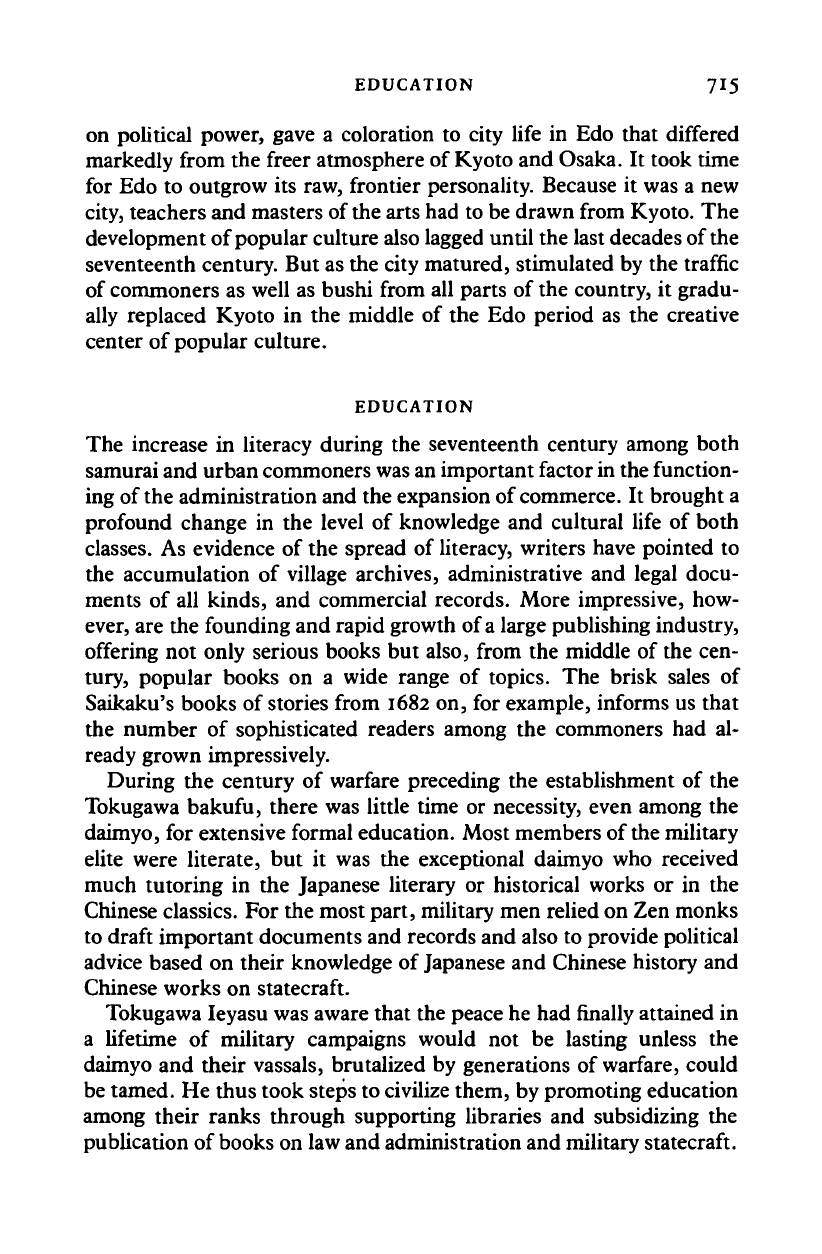
EDUCATION 715
on political power, gave a coloration to city life in Edo that differed
markedly from the freer atmosphere of Kyoto and Osaka. It took time
for Edo to outgrow its raw, frontier personality. Because it was a new
city, teachers and masters of the arts had to be drawn from Kyoto. The
development of popular culture also lagged until the last decades of the
seventeenth century. But as the city matured, stimulated by the traffic
of commoners as well as bushi from all parts of the country, it gradu-
ally replaced Kyoto in the middle of the Edo period as the creative
center of popular culture.
EDUCATION
The increase in literacy during the seventeenth century among both
samurai and urban commoners was an important factor in the function-
ing of the administration and the expansion of
commerce.
It brought a
profound change in the level of knowledge and cultural life of both
classes. As evidence of the spread of literacy, writers have pointed to
the accumulation of village archives, administrative and legal docu-
ments of all kinds, and commercial records. More impressive, how-
ever, are the founding and rapid growth of a large publishing industry,
offering not only serious books but also, from the middle of the cen-
tury, popular books on a wide range of topics. The brisk sales of
Saikaku's books of stories from 1682 on, for example, informs us that
the number of sophisticated readers among the commoners had al-
ready grown impressively.
During the century of warfare preceding the establishment of the
Tokugawa bakufu, there was little time or necessity, even among the
daimyo, for extensive formal education. Most members of
the
military
elite were literate, but it was the exceptional daimyo who received
much tutoring in the Japanese literary or historical works or in the
Chinese classics. For the most part, military men relied on Zen monks
to draft important documents and records and also to provide political
advice based on their knowledge of Japanese and Chinese history and
Chinese works on statecraft.
Tokugawa Ieyasu was aware that the peace he had finally attained in
a lifetime of military campaigns would not be lasting unless the
daimyo and their vassals, brutalized by generations of warfare, could
be tamed. He thus took steps to civilize them, by promoting education
among their ranks through supporting libraries and subsidizing the
publication of
books
on law and administration and military statecraft.
Cambridge Histories Online © Cambridge University Press, 2008
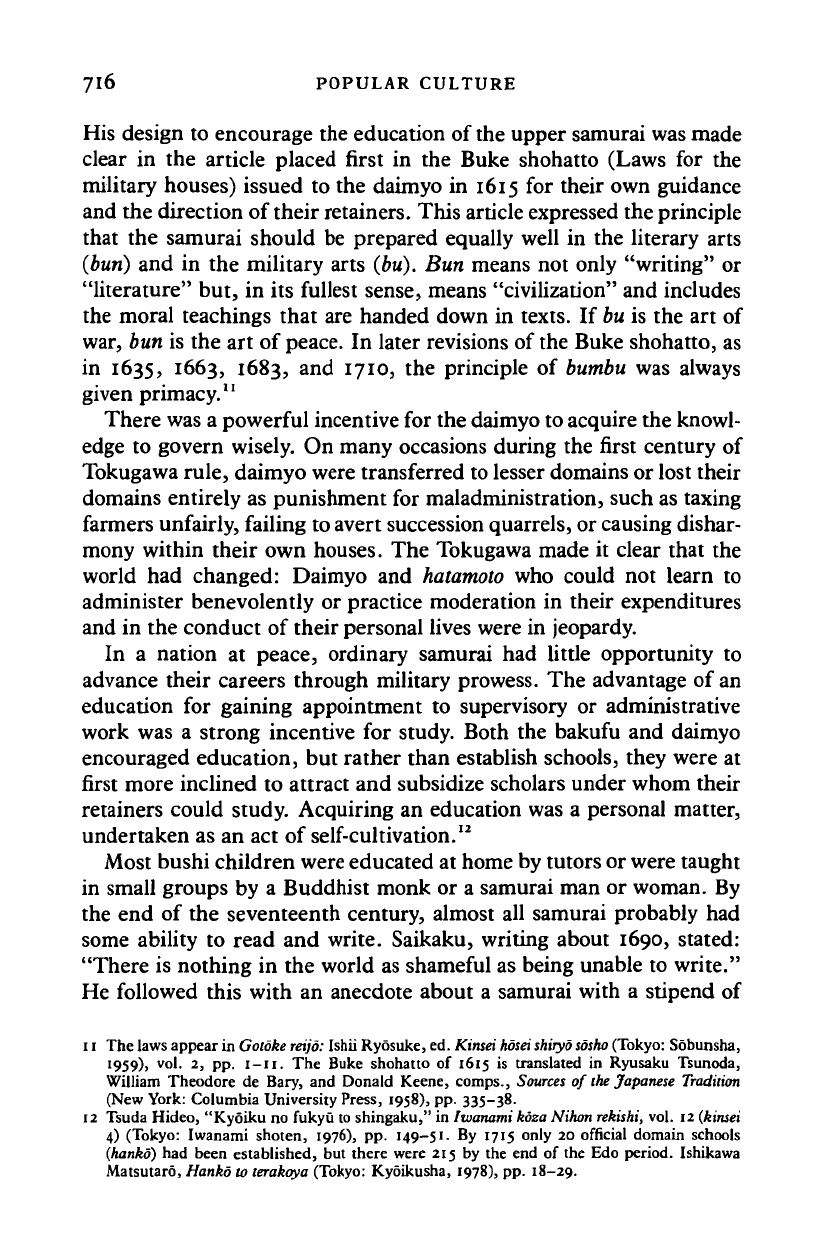
7l6 POPULAR CULTURE
His design
to
encourage the education of the upper samurai was made
clear
in the
article placed first
in the
Buke shohatto (Laws
for the
military houses) issued
to
the daimyo
in
1615
for
their own guidance
and the direction of their retainers. This article expressed the principle
that
the
samurai should
be
prepared equally well
in the
literary arts
(bun)
and in the
military arts (bu). Bun means
not
only "writing"
or
"literature" but,
in
its fullest sense, means "civilization" and includes
the moral teachings that are handed down
in
texts.
If
bu
is
the
art
of
war, bun
is
the art
of
peace.
In
later revisions
of
the Buke shohatto,
as
in 1635, 1663, 1683,
and
1710,
the
principle
of
bumbu
was always
given primacy."
There was a powerful incentive for the daimyo to acquire the knowl-
edge
to
govern wisely. On many occasions during the first century of
Tokugawa rule, daimyo were transferred to lesser domains or lost their
domains entirely as punishment
for
maladministration, such as taxing
farmers unfairly, failing to avert succession quarrels, or causing dishar-
mony within their own houses. The Tokugawa made
it
clear that
the
world
had
changed: Daimyo
and
hatamoto
who
could
not
learn
to
administer benevolently
or
practice moderation
in
their expenditures
and
in
the conduct
of
their personal lives were in jeopardy.
In
a
nation
at
peace, ordinary samurai
had
little opportunity
to
advance their careers through military prowess. The advantage
of
an
education
for
gaining appointment
to
supervisory
or
administrative
work was
a
strong incentive
for
study. Both
the
bakufu
and
daimyo
encouraged education, but rather than establish schools, they were
at
first more inclined to attract and subsidize scholars under whom their
retainers could study. Acquiring
an
education was
a
personal matter,
undertaken as
an
act
of
self-cultivation.
12
Most bushi children were educated at home by tutors or were taught
in small groups
by a
Buddhist monk
or a
samurai man or woman.
By
the end
of
the seventeenth century, almost
all
samurai probably
had
some ability
to
read
and
write. Saikaku, writing about 1690, stated:
"There
is
nothing
in
the world as shameful as being unable
to
write."
He followed this with
an
anecdote about
a
samurai with
a
stipend of
11 The laws appear in Gotoke
reijo:
Ishii Ryosuke, ed. Kinsei
hosei shiryo sosho
(Tokyo:
Sobunsha,
•959))
v
°l-
2
> PP-
1—11.
The
Buke shohatto
of 1615 is
translated
in
Ryusaku Tsunoda,
William Theodore
de
Bary,
and
Donald Keene, comps., Sources
of
the
Japanese Tradition
(New York: Columbia University Press, 1958), pp. 335-38.
12 Tsuda Hideo, "Kyoiku
no
fukyu to shingaku,"
in
Iwanami kbza Nihon
rekishi,
vol. 12
(kinsei
4) (Tokyo: Iwanami shoten, 1976),
pp.
149-51.
By 1715
only
20
official domain schools
(hanko)
had
been established,
but
there were
215 by the end of
the Edo period. Ishikawa
Matsutaro, Hanko to terakoya (Tokyo: Kyoikusha, 1978), pp. 18-29.
Cambridge Histories Online © Cambridge University Press, 2008
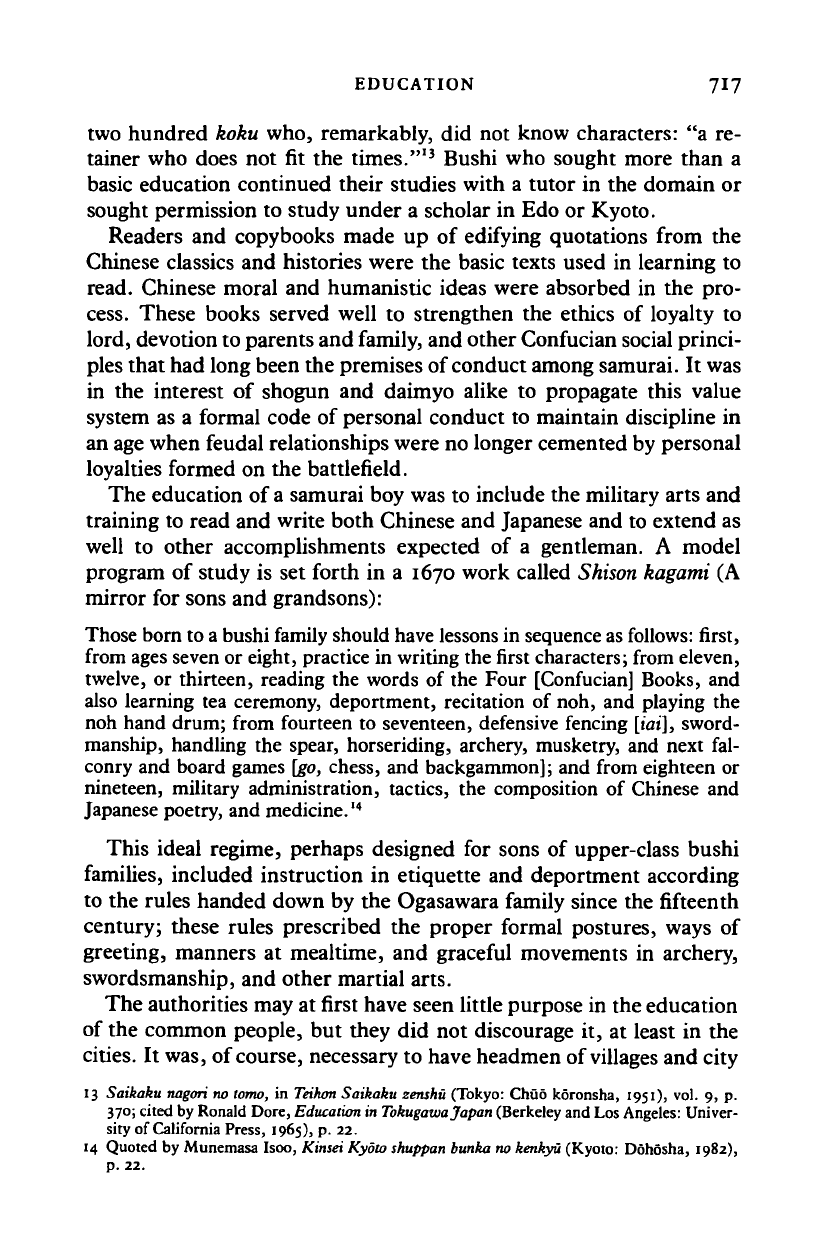
EDUCATION 717
two hundred koku who, remarkably, did not know characters: "a re-
tainer who does not fit the times.'"
3
Bushi who sought more than a
basic education continued their studies with a tutor in the domain or
sought permission to study under a scholar in Edo or Kyoto.
Readers and copybooks made up of edifying quotations from the
Chinese classics and histories were the basic texts used in learning to
read. Chinese moral and humanistic ideas were absorbed in the pro-
cess.
These books served well to strengthen the ethics of loyalty to
lord, devotion to parents and family, and other Confucian social princi-
ples that had long been the premises of conduct among samurai. It was
in the interest of shogun and daimyo alike to propagate this value
system as a formal code of personal conduct to maintain discipline in
an age when feudal relationships were no longer cemented by personal
loyalties formed on the battlefield.
The education of a samurai boy was to include the military arts and
training to read and write both Chinese and Japanese and to extend as
well to other accomplishments expected of a gentleman. A model
program of study is set forth in a 1670 work called Shison kagami (A
mirror for sons and grandsons):
Those born to a bushi family should have lessons in sequence as follows: first,
from ages seven or eight, practice in writing the first characters; from eleven,
twelve, or thirteen, reading the words of the Four [Confucian] Books, and
also learning tea ceremony, deportment, recitation of noh, and playing the
noh hand drum; from fourteen to seventeen, defensive fencing
[iai],
sword-
manship, handling the spear, horseriding, archery, musketry, and next fal-
conry and board games
[go,
chess, and backgammon]; and from eighteen or
nineteen, military administration, tactics, the composition of Chinese and
Japanese poetry, and medicine.
14
This ideal regime, perhaps designed for sons of upper-class bushi
families, included instruction in etiquette and deportment according
to the rules handed down by the Ogasawara family since the fifteenth
century; these rules prescribed the proper formal postures, ways of
greeting, manners at mealtime, and graceful movements in archery,
swordsmanship, and other martial arts.
The authorities may at first have seen little purpose in the education
of the common people, but they did not discourage it, at least in the
cities.
It was, of course, necessary to have headmen of villages and city
13 Saikaku nagori no tomo, in
Teihon
Saikaku zenshu (Tokyo: Chuo kdronsha, 1951), vol. 9, p.
370;
cited by Ronald Dore, Education in Tokugawa Japan (Berkeley and Los Angeles: Univer-
sity of California Press, 1965), p. 22.
14 Quoted by Munemasa Isoo, Kinsei Kyoto
shuppan
bunka
no
kenkyu (Kyoto: Dohosha, 1982),
p.
22.
Cambridge Histories Online © Cambridge University Press, 2008
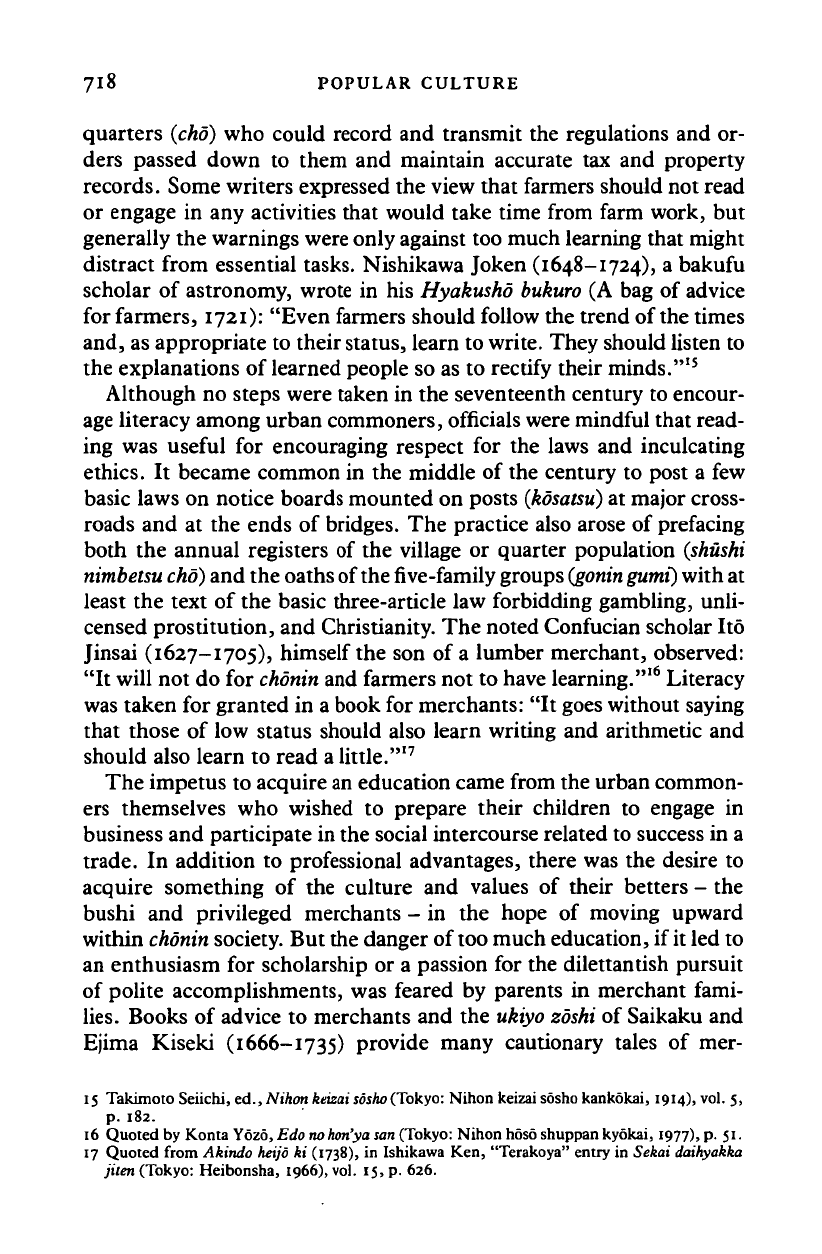
718 POPULAR CULTURE
quarters
(cho)
who could record and transmit the regulations and or-
ders passed down to them and maintain accurate tax and property
records. Some writers expressed the view that farmers should not read
or engage in any activities that would take time from farm work, but
generally the warnings were only against too much learning that might
distract from essential tasks. Nishikawa Joken (1648-1724), a bakufu
scholar of astronomy, wrote in his Hyakusho
bukuro
(A bag of advice
for farmers, 1721): "Even farmers should follow the trend of
the
times
and, as appropriate to their status, learn to write. They should listen to
the explanations of learned people so as to rectify their minds."
15
Although no steps were taken in the seventeenth century to encour-
age literacy among urban commoners, officials were mindful that read-
ing was useful for encouraging respect for the laws and inculcating
ethics.
It became common in the middle of the century to post a few
basic laws on notice boards mounted on posts
(kosatsu)
at major cross-
roads and at the ends of bridges. The practice also arose of prefacing
both the annual registers of the village or quarter population
(shushi
nimbetsu cho)
and the oaths of the
five-family
groups
(gonin gumi)
with at
least the text of the basic three-article law forbidding gambling, unli-
censed prostitution, and Christianity. The noted Confucian scholar Ito
Jinsai (1627-1705), himself the son of a lumber merchant, observed:
"It will not do for
chonin
and farmers not to have learning."
16
Literacy
was taken for granted in a book for merchants: "It goes without saying
that those of low status should also learn writing and arithmetic and
should also learn to read a little.'"
7
The impetus to acquire an education came from the urban common-
ers themselves who wished to prepare their children to engage in
business and participate in the social intercourse related to success in a
trade. In addition to professional advantages, there was the desire to
acquire something of the culture and values of their betters - the
bushi and privileged merchants - in the hope of moving upward
within
chonin
society. But the danger of too much education, if it led to
an enthusiasm for scholarship or a passion for the dilettantish pursuit
of polite accomplishments, was feared by parents in merchant fami-
lies.
Books of advice to merchants and the
ukiyo zoshi
of Saikaku and
Ejima Kiseki (1666-1735) provide many cautionary tales of mer-
15 Takimoto Seiichi, ed., Nihon keizai
sosho
(Tokyo: Nihon keizai sosho kankokai, 1914), vol. 5,
p.
182.
16 Quoted by Konta Yozo, Edo
no hon'ya san
(Tokyo: Nihon hoso shuppan kyokai, 1977), p. 51.
17 Quoted from Akindo heijo ki (1738), in Ishikawa Ken, "Terakoya" entry in Sekai daihyakka
jilen (Tokyo: Heibonsha, 1966), vol. 15, p. 626.
Cambridge Histories Online © Cambridge University Press, 2008
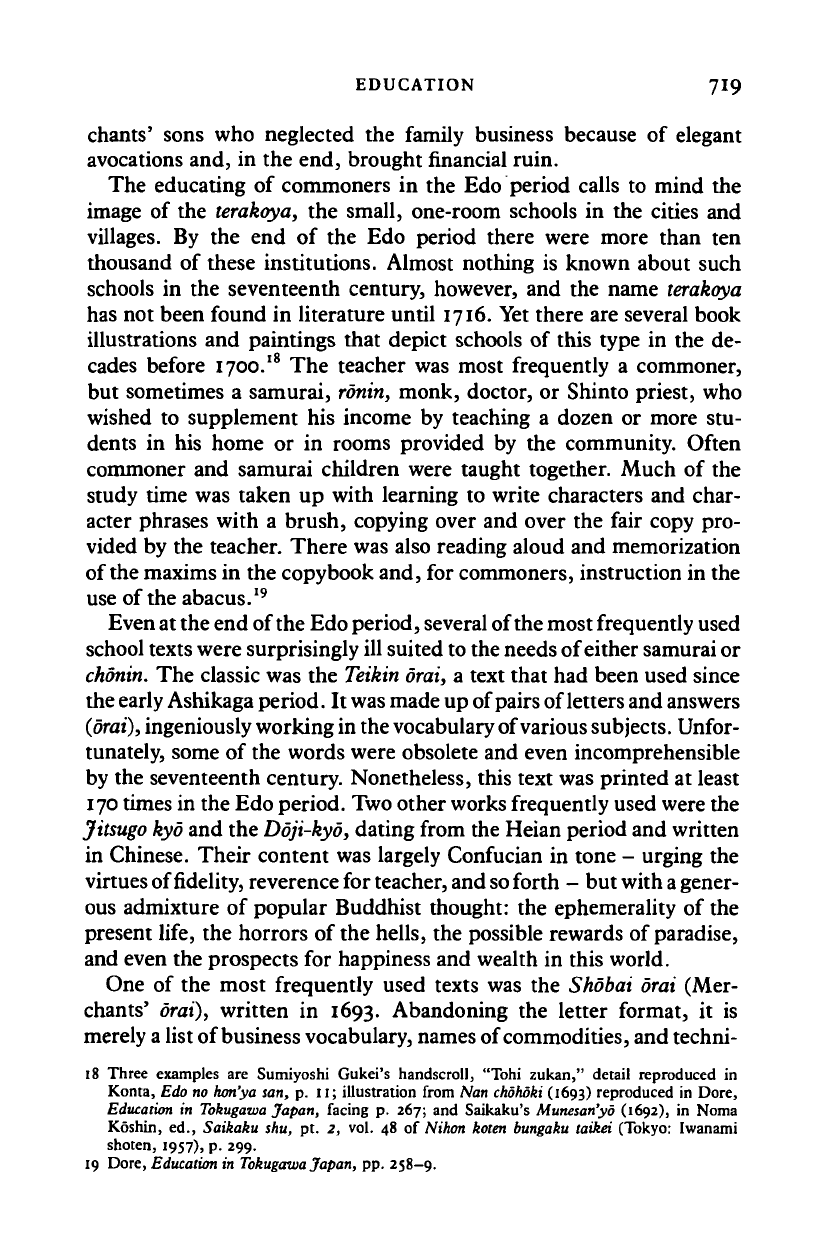
EDUCATION 719
chants' sons who neglected the family business because of elegant
avocations and, in the end, brought financial ruin.
The educating of commoners in the Edo period calls to mind the
image of the
terakoya,
the small, one-room schools in the cities and
villages. By the end of the Edo period there were more than ten
thousand of these institutions. Almost nothing is known about such
schools in the seventeenth century, however, and the name
terakoya
has not been found in literature until 1716. Yet there are several book
illustrations and paintings that depict schools of this type in the de-
cades before 1700.
18
The teacher was most frequently a commoner,
but sometimes a samurai,
ronin,
monk, doctor, or Shinto priest, who
wished to supplement his income by teaching a dozen or more stu-
dents in his home or in rooms provided by the community. Often
commoner and samurai children were taught together. Much of the
study time was taken up with learning to write characters and char-
acter phrases with a brush, copying over and over the fair copy pro-
vided by the teacher. There was also reading aloud and memorization
of
the
maxims in the copybook and, for commoners, instruction in the
use of the abacus.
19
Even at the end of the Edo period, several of the most frequently used
school texts were surprisingly ill suited to the needs of either samurai or
chonin.
The classic was the
Teikin
orai,
a text that had been used since
the
early Ashikaga period. It
was
made up of pairs of letters and answers
(orai),
ingeniously working in the vocabulary of various
subjects.
Unfor-
tunately, some of the words were obsolete and even incomprehensible
by the seventeenth century. Nonetheless, this text was printed at least
170
times in the Edo period. Two other works frequently used were the
Jitsugo kyo
and the
Doji-kyo,
dating from the Heian period and written
in Chinese. Their content was largely Confucian in tone - urging the
virtues of fidelity, reverence for teacher, and
so
forth - but with
a
gener-
ous admixture of popular Buddhist thought: the ephemerality of the
present life, the horrors of the hells, the possible rewards of paradise,
and even the prospects for happiness and wealth in this world.
One of the most frequently used texts was the Shobai orai (Mer-
chants' orai), written in 1693. Abandoning the letter format, it is
merely
a
list of business vocabulary, names of commodities, and techni-
18 Three examples are Sumiyoshi Gukei's handscroll, "Tohi zukan," detail reproduced in
Konta, Edo no hon'ya san, p. n; illustration from Nan
chohoki
(1693) reproduced in Dore,
Education in Tokugawa Japan, facing p. 267; and Saikaku's Munesan'yo (1692), in Noma
Koshin, ed., Saikaku shu, pt. 2, vol. 48 of Nihon koten bungaku taikei (Tokyo: Iwanami
shoten, 1957), p. 299.
19 Dore, Education in
Tokugawa
Japan, pp. 258-9.
Cambridge Histories Online © Cambridge University Press, 2008
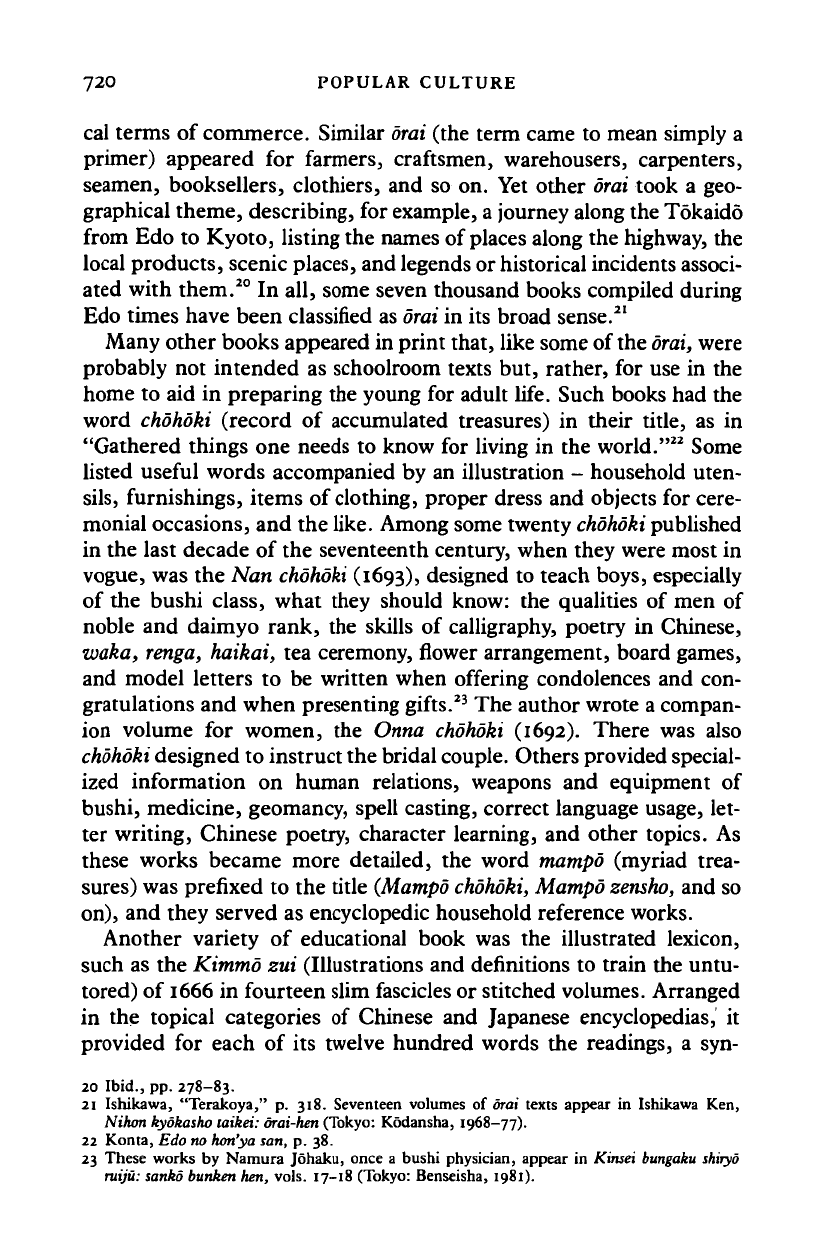
720 POPULAR CULTURE
cal terms of commerce. Similar
orai
(the term came to mean simply a
primer) appeared for farmers, craftsmen, warehousers, carpenters,
seamen, booksellers, clothiers, and so on. Yet other
orai
took a geo-
graphical theme, describing, for example, a journey along the Tokaido
from Edo to Kyoto, listing the names of places along the highway, the
local products, scenic places, and legends or historical incidents associ-
ated with them.
20
In all, some seven thousand books compiled during
Edo times have been classified as
orai
in its broad sense.
21
Many other books appeared in print that, like some of the
orai,
were
probably not intended as schoolroom texts but, rather, for use in the
home to aid in preparing the young for adult life. Such books had the
word chohoki (record of accumulated treasures) in their title, as in
"Gathered things one needs to know for living in the world."
22
Some
listed useful words accompanied by an illustration - household uten-
sils,
furnishings, items of clothing, proper dress and objects for cere-
monial occasions, and the
like.
Among some twenty
chohoki
published
in the last decade of the seventeenth century, when they were most in
vogue, was the Nan
chohoki
(1693), designed to teach boys, especially
of the bushi class, what they should know: the qualities of men of
noble and daimyo rank, the skills of calligraphy, poetry in Chinese,
waka,
renga,
haikai, tea ceremony, flower arrangement, board games,
and model letters to be written when offering condolences and con-
gratulations and when presenting gifts.
23
The author wrote a compan-
ion volume for women, the Onna chohoki (1692). There was also
chohoki
designed to instruct the bridal
couple.
Others provided special-
ized information on human relations, weapons and equipment of
bushi, medicine, geomancy, spell casting, correct language usage, let-
ter writing, Chinese poetry, character learning, and other topics. As
these works became more detailed, the word mampo (myriad trea-
sures) was prefixed to the title
(Mampo
chohoki,
Mampo
zensho,
and so
on),
and they served as encyclopedic household reference works.
Another variety of educational book was the illustrated lexicon,
such as the Kimmo zui (Illustrations and definitions to train the untu-
tored) of 1666 in fourteen slim fascicles or stitched volumes. Arranged
in the topical categories of Chinese and Japanese encyclopedias, it
provided for each of its twelve hundred words the readings, a syn-
20 Ibid., pp. 278-83.
21 Ishikawa, "Terakoya," p. 318. Seventeen volumes of orai texts appear in Ishikawa Ken,
Nihon kyokasho taikei: orai-hen (Tokyo: Kodansha, 1968-77).
22 Konta, Edo no hon'ya san, p. 38.
23 These works by Namura Johaku, once a bushi physician, appear in Kinsei
bungaku
shiryo
ruiju: sanko bunken hen, vols. 17-18 (Tokyo: Benseisha, 1981).
Cambridge Histories Online © Cambridge University Press, 2008
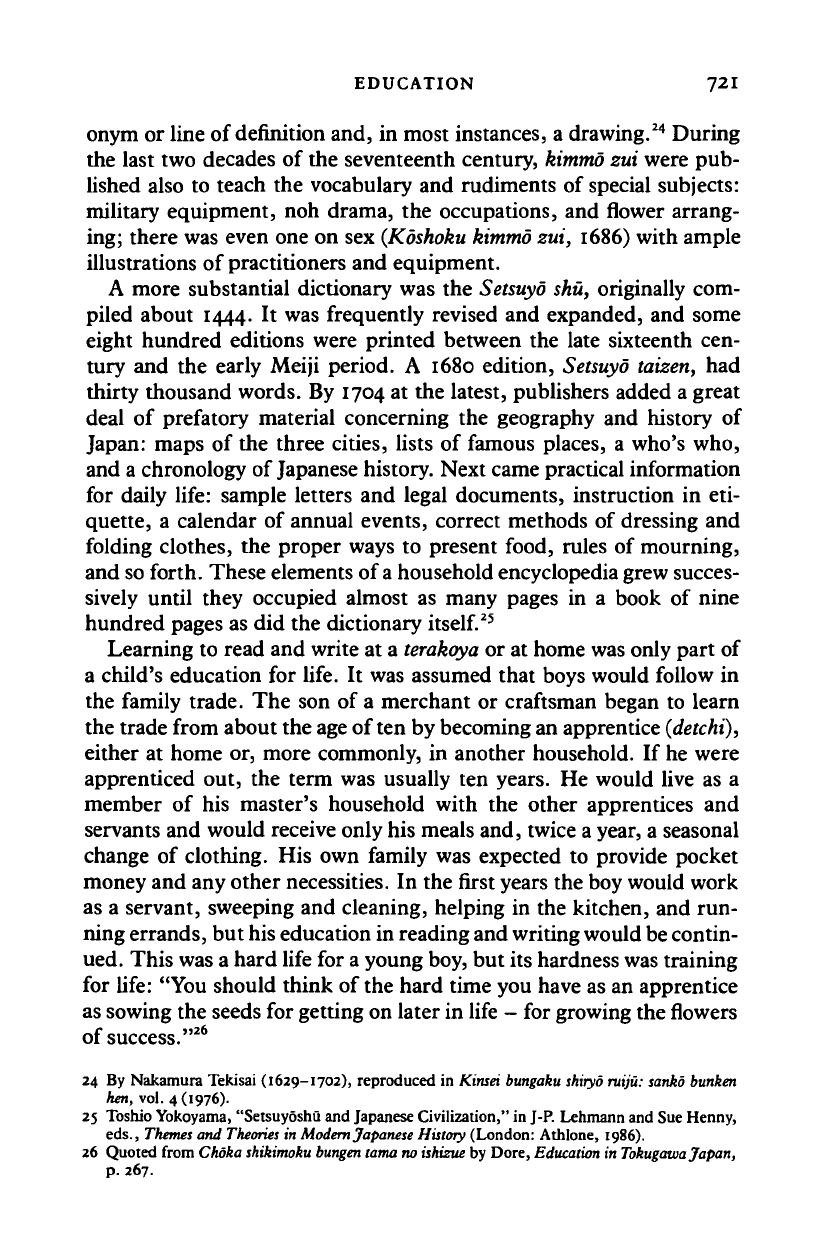
EDUCATION 721
onym or line of definition and, in most instances, a drawing.
24
During
the last two decades of the seventeenth century,
kimmo
zui were pub-
lished also to teach the vocabulary and rudiments of special subjects:
military equipment, noh drama, the occupations, and flower arrang-
ing; there was even one on sex
(Koshoku kimmo
zui, 1686) with ample
illustrations of practitioners and equipment.
A more substantial dictionary was the
Setsuyo
shu,
originally com-
piled about 1444. It was frequently revised and expanded, and some
eight hundred editions were printed between the late sixteenth cen-
tury and the early Meiji period. A 1680 edition,
Setsuyo
taizen, had
thirty thousand words. By 1704 at the latest, publishers added a great
deal of prefatory material concerning the geography and history of
Japan: maps of the three cities, lists of famous places, a who's who,
and a chronology of Japanese history. Next came practical information
for daily life: sample letters and legal documents, instruction in eti-
quette, a calendar of annual events, correct methods of dressing and
folding clothes, the proper ways to present food, rules of mourning,
and so forth. These elements of a household encyclopedia grew succes-
sively until they occupied almost as many pages in a book of nine
hundred pages as did the dictionary
itself.
25
Learning to read and write at a
terakoya
or at home was only part of
a child's education for life. It was assumed that boys would follow in
the family trade. The son of a merchant or craftsman began to learn
the trade from about the age of ten by becoming an apprentice
(detchi),
either at home or, more commonly, in another household. If he were
apprenticed out, the term was usually ten years. He would live as a
member of his master's household with the other apprentices and
servants and would receive only his meals and, twice a year, a seasonal
change of clothing. His own family was expected to provide pocket
money and any other necessities. In the first years the boy would work
as a servant, sweeping and cleaning, helping in the kitchen, and run-
ning errands, but his education in reading and writing would be contin-
ued. This was a hard life for a young boy, but its hardness was training
for life: "You should think of the hard time you have as an apprentice
as sowing the seeds for getting on later in life - for growing the flowers
of success."
26
24 By Nakamura Tekisai (1629-1702), reproduced in Kinsei
bungaku shiryo
ruiju:
sanko bunken
hen,
vol. 4 (1976).
25 Toshio Yokoyama, "Setsuyoshu and Japanese Civilization," in J-P. Lehmann and Sue Henny,
eds.,
Themes
and
Theories
in Modem Japanese History (London: Athlone, 1986).
26 Quoted from Choka
shikimoku bungen
lama
no
ishizue by Dore,
Education
in Tokugawa Japan,
p.
267.
Cambridge Histories Online © Cambridge University Press, 2008
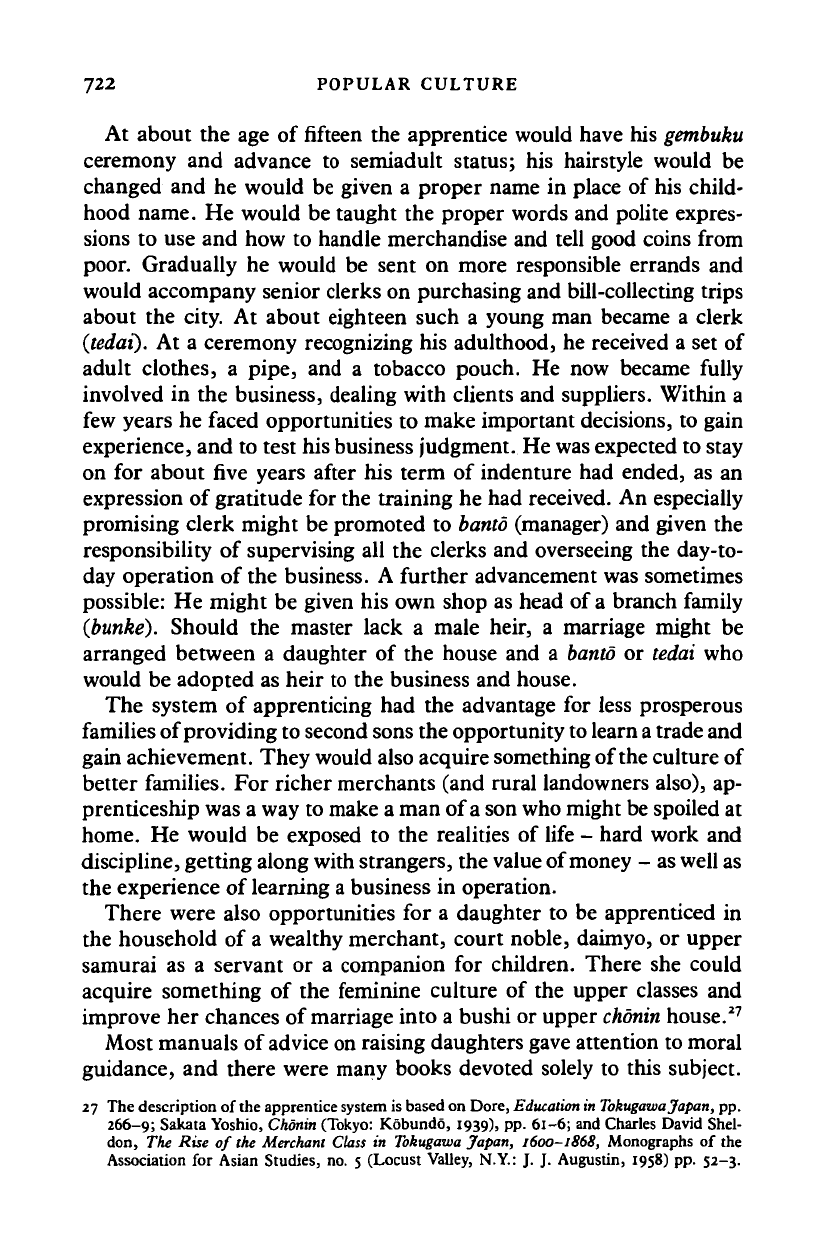
722 POPULAR CULTURE
At about the age of fifteen the apprentice would have his
gembuku
ceremony and advance to semiadult status; his hairstyle would be
changed and he would be given a proper name in place of his child-
hood name. He would be taught the proper words and polite expres-
sions to use and how to handle merchandise and tell good coins from
poor. Gradually he would be sent on more responsible errands and
would accompany senior clerks on purchasing and bill-collecting trips
about the city. At about eighteen such a young man became a clerk
(tedai).
At a ceremony recognizing his adulthood, he received a set of
adult clothes, a pipe, and a tobacco pouch. He now became fully
involved in the business, dealing with clients and suppliers. Within a
few years he faced opportunities to make important decisions, to gain
experience, and to test his business judgment. He was expected to stay
on for about five years after his term of indenture had ended, as an
expression of gratitude for the training he had received. An especially
promising clerk might be promoted to
banto
(manager) and given the
responsibility of supervising all the clerks and overseeing the day-to-
day operation of the business. A further advancement was sometimes
possible: He might be given his own shop as head of
a
branch family
(bunke).
Should the master lack a male heir, a marriage might be
arranged between a daughter of the house and a
banto
or
tedai
who
would be adopted as heir to the business and house.
The system of apprenticing had the advantage for less prosperous
families of providing to second sons the opportunity
to
learn
a
trade and
gain achievement. They would also acquire something of the culture of
better families. For richer merchants (and rural landowners also), ap-
prenticeship was a way to make a man of a son who might be spoiled at
home. He would be exposed to the realities of life - hard work and
discipline, getting along with strangers, the value of money - as well as
the experience of learning
a
business in operation.
There were also opportunities for a daughter to be apprenticed in
the household of a wealthy merchant, court noble, daimyo, or upper
samurai as a servant or a companion for children. There she could
acquire something of the feminine culture of the upper classes and
improve her chances of marriage into a bushi or upper
chonin
house.
27
Most manuals of advice on raising daughters gave attention to moral
guidance, and there were many books devoted solely to this subject.
27 The description of the apprentice system is based on
Dore,
Education in
Tokugawa Japan, pp.
266-9;
Sakata Yoshio,
Chonin
(Tokyo: Kobundo, 1939), pp. 61-6; and Charles David Shel-
don, The Rise of
the Merchant Class
in
Tokugawa
Japan, 1600-1868, Monographs of the
Association for Asian Studies, no. 5 (Locust Valley, N.Y.: J. J. Augustin, 1958) pp. 52-3.
Cambridge Histories Online © Cambridge University Press, 2008
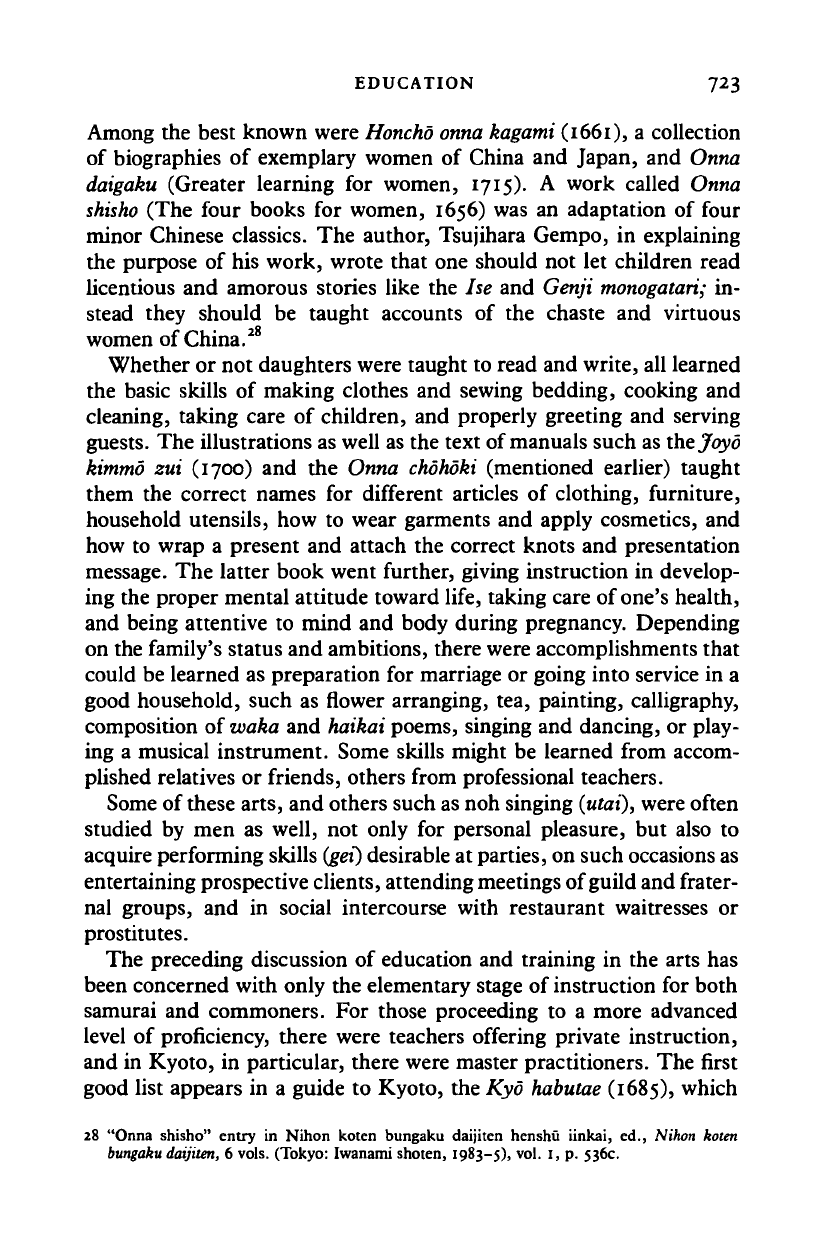
EDUCATION 723
Among the best known were
Honcho onna kagami
(1661), a collection
of biographies of exemplary women of China and Japan, and Onna
daigaku (Greater learning for women, 1715). A work called Onna
shisho
(The four books for women, 1656) was an adaptation of four
minor Chinese classics. The author, Tsujihara Gempo, in explaining
the purpose of his work, wrote that one should not let children read
licentious and amorous stories like the he and Genji
monogatari;
in-
stead they should be taught accounts of the chaste and virtuous
women of China.
28
Whether or not daughters were taught to read and write, all learned
the basic skills of making clothes and sewing bedding, cooking and
cleaning, taking care of children, and properly greeting and serving
guests. The illustrations as well as the text of manuals such as the Joy6
kimmo zui (1700) and the Onna
chohoki
(mentioned earlier) taught
them the correct names for different articles of clothing, furniture,
household utensils, how to wear garments and apply cosmetics, and
how to wrap a present and attach the correct knots and presentation
message. The latter book went further, giving instruction in develop-
ing the proper mental attitude toward life, taking care of one's health,
and being attentive to mind and body during pregnancy. Depending
on the family's status and ambitions, there were accomplishments that
could be learned as preparation for marriage or going into service in a
good household, such as flower arranging, tea, painting, calligraphy,
composition of waka and
haikai
poems, singing and dancing, or play-
ing a musical instrument. Some skills might be learned from accom-
plished relatives or friends, others from professional teachers.
Some of these arts, and others such as noh singing
(utai),
were often
studied by men as well, not only for personal pleasure, but also to
acquire performing skills
(gei)
desirable at parties, on such occasions as
entertaining prospective clients, attending meetings of guild and frater-
nal groups, and in social intercourse with restaurant waitresses or
prostitutes.
The preceding discussion of education and training in the arts has
been concerned with only the elementary stage of instruction for both
samurai and commoners. For those proceeding to a more advanced
level of proficiency, there were teachers offering private instruction,
and in Kyoto, in particular, there were master practitioners. The first
good list appears in a guide to Kyoto, the Kyo
habutae
(1685), which
28 "Onna shisho" entry in Nihon koten bungaku daijiten henshu iinkai, ed., Nihon koten
bungaku daijiten, 6 vols. (Tokyo: Iwanami shoten, 1983-5), vol. 1, p. 536c.
Cambridge Histories Online © Cambridge University Press, 2008
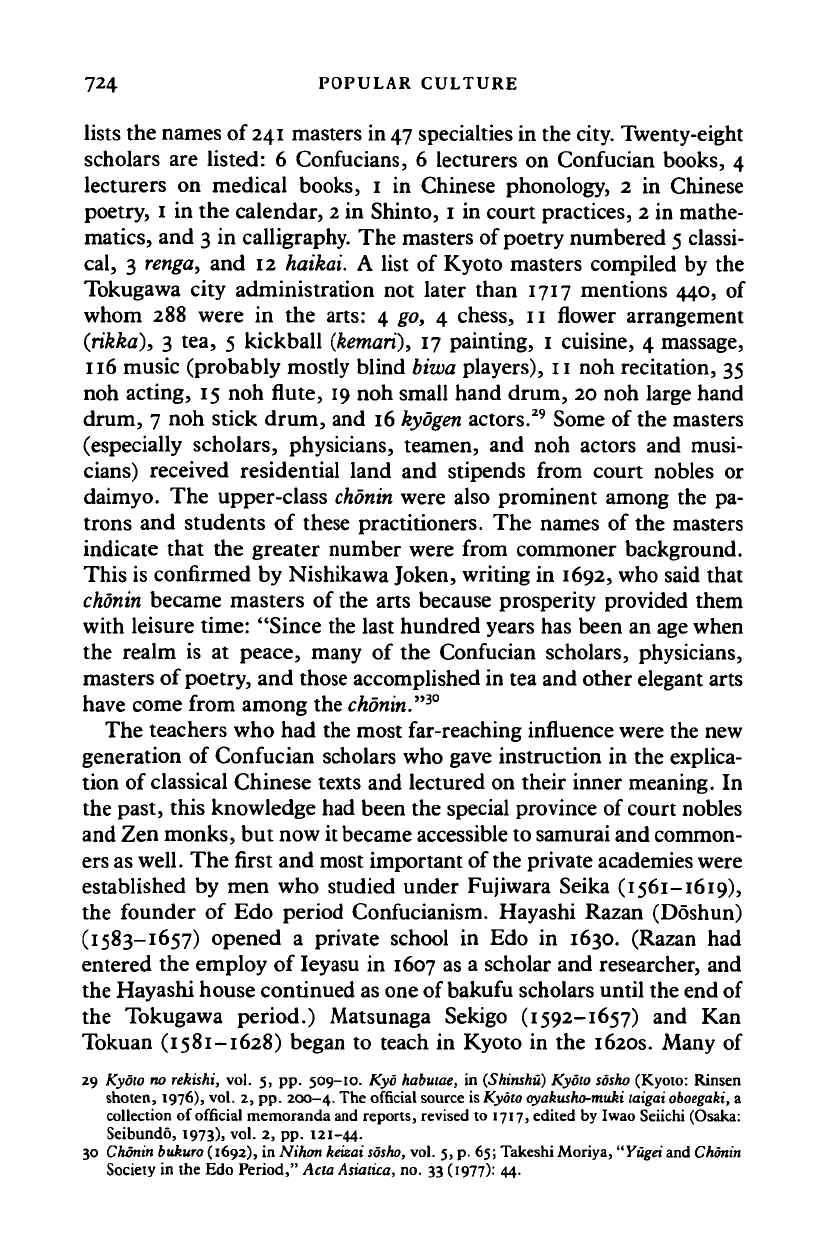
724 POPULAR CULTURE
lists the names of 241 masters in
47
specialties in the
city.
Twenty-eight
scholars are listed: 6 Confucians, 6 lecturers on Confucian books, 4
lecturers on medical books, 1 in Chinese phonology, 2 in Chinese
poetry, 1 in the calendar, 2 in Shinto,
1
in court practices, 2 in mathe-
matics, and 3 in calligraphy. The masters of poetry numbered 5 classi-
cal,
3
renga,
and 12 haikai. A list of Kyoto masters compiled by the
Tokugawa city administration not later than 1717 mentions 440, of
whom 288 were in the arts: 4 go, 4 chess, 11 flower arrangement
(rikka),
3 tea, 5 kickball
(kemari),
17 painting, 1 cuisine, 4 massage,
116 music (probably mostly blind biwa players), 11 noh recitation, 35
noh acting, 15 noh flute, 19 noh small hand drum, 20 noh large hand
drum, 7 noh stick drum, and 16
kyogen
actors.
29
Some of the masters
(especially scholars, physicians, teamen, and noh actors and musi-
cians) received residential land and stipends from court nobles or
daimyo. The upper-class
chonin
were also prominent among the pa-
trons and students of these practitioners. The names of the masters
indicate that the greater number were from commoner background.
This is confirmed by Nishikawa Joken, writing in 1692, who said that
chonin
became masters of the arts because prosperity provided them
with leisure time: "Since the last hundred years has been an age when
the realm is at peace, many of the Confucian scholars, physicians,
masters of
poetry,
and those accomplished in tea and other elegant arts
have come from among the
chonin."
30
The teachers who had the most far-reaching influence were the new
generation of Confucian scholars who gave instruction in the explica-
tion of classical Chinese texts and lectured on their inner meaning. In
the past, this knowledge had been the special province of court nobles
and Zen monks, but now it became accessible to samurai and common-
ers as well. The first and most important of the private academies were
established by men who studied under Fujiwara Seika (1561-1619),
the founder of Edo period Confucianism. Hayashi Razan (Doshun)
(1583-1657) opened a private school in Edo in 1630. (Razan had
entered the employ of Ieyasu in 1607 as a scholar and researcher, and
the Hayashi house continued as one of bakufu scholars until the end of
the Tokugawa period.) Matsunaga Sekigo (1592-1657) and Kan
Tokuan (1581-1628) began to teach in Kyoto in the 1620s. Many of
29 Kyoto no rekishi, vol. 5, pp. 509-10. Kyo habutae, in (Shinshu) Kyoto
sosho
(Kyoto: Rinsen
shoten, 1976), vol. 2, pp. 200-4. The official source is Kyoto
oyakusho-muki
taigai
oboegaki,
a
collection of official memoranda and reports, revised to 1717, edited by Iwao Seiichi (Osaka:
Seibundo, 1973), vol. 2, pp. 121-44.
30 Chonin
bukuro
(1692), in Nihon keizai
sosho,
vol. 5, p. 65; Takeshi Moriya, "Yugei and
Chonin
Society in the Edo Period," Acta Asiatica, no. 33 (1977): 44.
Cambridge Histories Online © Cambridge University Press, 2008
